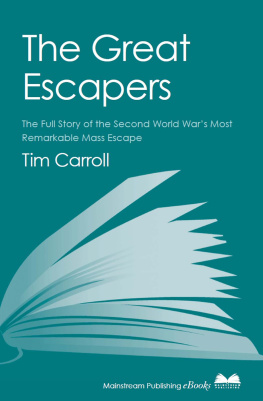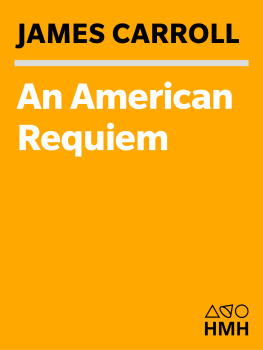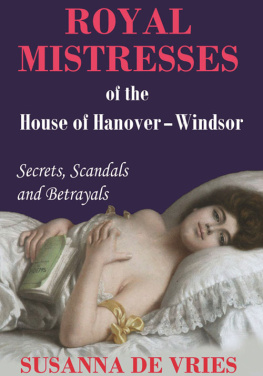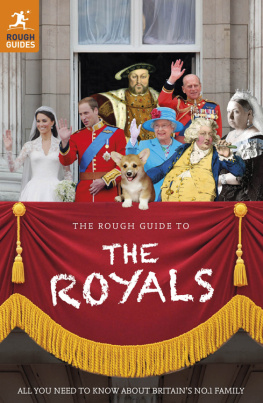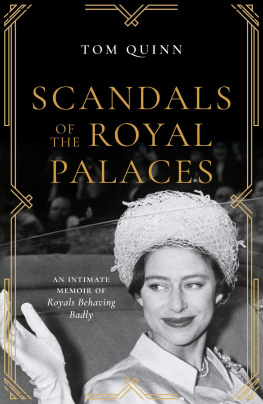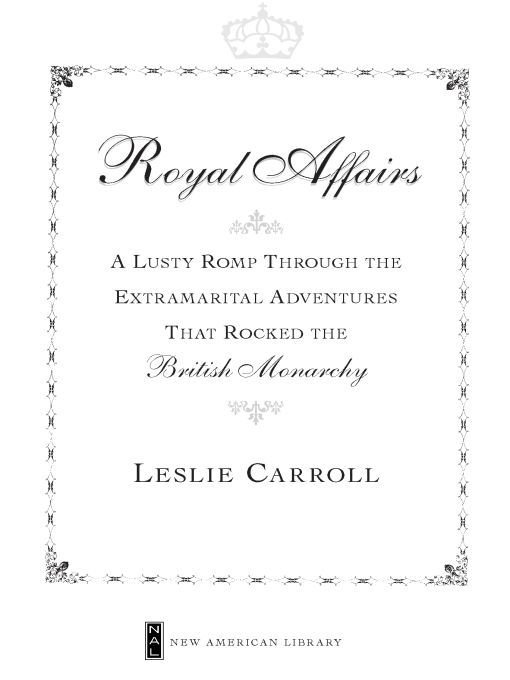Table of Contents
For my loving, patient, wildly supportive, and remarkably understanding husband, Scott, who endured my devoting nearly every waking hour of our first half year of marriage to a book on adultery
Foreword
Sex and power have always gone hand in glove, and monarchs have been merry throughout history. Nothing can bring down a governmentnot even high treasonlike a good sex scandal. Nowadays people yawn through newspaper accounts of civil warfare, economic downturns, even reports of appalling corporate greed. But give them a juicy sex scandal peppered with high and mighty protagonists, and its the first story readers turn to. We can never seem to get enough of them.
Americans, in particular, enjoy a collective love affair with monarchiesprobably because we dont have one, and can sanctimoniously feel superior to those benighted blighters who God and birthright have placed above the peons of their respective nations, yet who still manage to be more than human. Americans have Hollywood royalty instead, or myriad professional sports stars, pop icons, and politicians who behave badly. But nothing seems to be quite as alluring as a royal affair.
Were hopelessly hooked because these people with titles straight out of fairy tales or romance novels are behaving humanly, yet at the same time they remain larger than life. The royals have the same desires and passions as the rest of us, but the consequences of their choices are biggerand in some cases, disastrous.
How did their spouses feel about their amorous romps? Most of the time the kings wives were queen consortsqueens only by virtue of their marriagenot regnant queens who ruled the realm in their own right by virtue of succession, such as Elizabeth I, Anne, or Victoria. Queen consorts were expected to put up and shut up when the king strayed from the conjugal bed, and to produce the requisite heir and a spare that would guarantee the healthy succession of the kingdom.
Most marriages, especially royal ones, were primarily political and economic alliances, so its hard to vilify these imperial adulterers for seeking sexual satisfaction outside the marital bed. And, given the state of hygiene at the time, one might imagine that an unattractive spouse was made all the more repulsive by an inattention to such delicacies. When in 1795 the future George IV was introduced to his betrothed, the odiferous, piggy-looking Caroline of Brunswick, he exclaimed to the Earl of Malmesbury, Harris, I am not very well, pray get me a glass of brandy. The prince remained drunk for the next three days until he was dragged to the altar.
A third factor might account for all the debauchery. Any ninth-grade science student can discourse on the dangers of marrying ones first cousin, yet during the past thousand years or so, there was so much intermarriage among the royal houses that many of these inbred monarchs were mentally unbalanced to one degree or another, giving new meaning to the phrase mad for love.
Throughout the centuries, royal affairs have engendered substantially more than salacious gossip. Often they have caused bloodshed. For example, Edward IIs homosexual affairs with Piers Gaveston and Hugh Despenser the Younger infuriated his barons and alienated his wife, Queen Isabella, who decided to have an extramarital affair of her own. The vicious cycle of adultery, murder, and betrayal resulted in the overthrow of the monarchy, the kings imprisonment, and quite possibly, his assassination.
The unholy trinity of sex and politics is incomplete without religion. And a study of the extramarital affairs of Great Britains royals also ends up chronicling the journey of the realms religious history. Henry VIIIs passion for Anne Boleyn culminated not only in their marriage but in a brand-new faith that created a lasting schism with the Church of Rome, and led to hundreds of years of strife and violence among Catholics, Protestants, and Puritans that would have a lasting impact on millions of lives.
It wasnt possible within the confines of this volume to spotlight every single monarch or to include each royal tryst, particularly when some sovereigns were such serial adulterers that one wonders how they had time to attend to affairs of state. Their conquests alone could fill volumes. The scuffling of silk slippers on the back stairs of Charles IIs royal apartments was apparently so frequent that the king maintained a pair of discreet gatekeepers to control the flow of traffic.
And what of the mistresses? During the earlier, and more brutal, eras of British history, a woman didnt have much (if any) choice if the king exercised his droit de seigneur and decided to take her to bed. Often, girls were little more than adolescents when their ambitious parents shoved them under the monarchs nose. However, most of the mistresses in Royal Affairs were not innocent victims of a parents political agenda or a monarchs rampaging lust. They were clever, accomplished, often ambitious women, not always in the first bloom of youth and not always baseborn, who cannily parlayed the only thing they hadtheir bodiesinto extravagant wealth and notoriety, if not outright fame. In many cases, their royal bastards were ennobled by the king, making excellent marriages and living far better than their mothers could have otherwise provided. Eventually taking their place in the House of Lords, the mistresses illegitimate sons went on to become the decision makers who shaped an empire and spawned the richest and most powerful families in Britain.
A delicious little incident that attests to the staying power and influence of a royal mistress occurred during the reign of King George I, when the Duchess of Portsmouth (Charles IIs French mistress Louise de Kroualle), the Countess of Dorchester (a former mistress of James II), and the Countess of Orkney (William IIIs mistress Elizabeth Villiers Hamilton) all met at the same reception. The Countess of Orkney, known for her rapier wit, regarded her compatriots and quipped, Who would have thought that we three whores should meet here?
Incongruous as it may sound, Englands trajectory from absolute to constitutional monarchy can be traced through the history of its sovereigns sex scandals. Rough justice and kangaroo courts once dispatched any dissenters from the royal agenda; when an absolute monarch who ruled by divine right shouted Off with her head! it tended to take care of matters.
As time went on, the power of the public, from Parliament to the press, steadily eroded the sovereigns supremacy, until, by the mid-1930s, King Edward VIII, a constitutional monarch with limited input in the workings of the government, felt compelled to abdicate, believing that the tide of public opinion was against his love match. In fact, suppressed by the press, the very opposite attitude was true.
One thing is for certain: Marriage vows be damned, royals are just as randy now as they ever were. Is such behavior traceable to centuries of inbreeding or is it their sense of noblesse oblige?
From Henry IIs blatant disregard of international treaties and alliances in favor of his young French mistress to Edward VIIIs abdication for the woman he loved; from Henry VIII beheading his adulterous wives on Tower Green to Charles and Diana discussing their extramarital infidelities on national television, the world has in fact come a long way. Or has it? In the history of royal scandals is writ the ever-evolving story of our own society.


